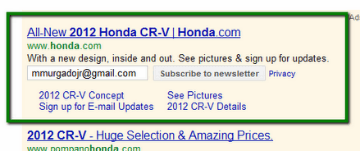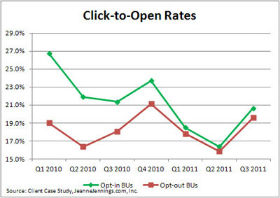The From Line
 Asked by Lorrain, 'I’m not allowed to tell you' agency
Asked by Lorrain, 'I’m not allowed to tell you' agency
Answer by Sara Steinnagel, Community Manager.
Email Marketing campaigns
Based on this question, it sounds as if your agency is simply not educated about the overall value email marketing provides. Email should be the backbone of an integrated on or offline campaign helping to build and reinforce customer relationships. What happens when the campaign is over? Do customer relationships fizzle? Why bother collecting all that permissioned data and not use it? Doesn't your agency view this as a wasted opportunity? Aren’t your clients’ customers expecting to hear from them?
Email Marketing Value
According to the Direct Marketing Association’s 2011 Power of Direct report, email is bringing in $40.56 for every dollar spent on it in 2011, compared to catalogs' ROI of $7.30, search's return of $22.24, Internet display advertising's return of $19.72 and mobile's return of $10.51. Email is the most cost effective digital marketing medium there is. Granted, building a quality email program tends to be more complex than for other digital mediums, however the payoff can easily be substantiated. Convincing your account management team about the value of email marketing is a function of education. Like all educational processes, it will be slow and mastery will take time. Eventually your account team will need to garner enough confidence to pitch the client accordingly. If your account team seems reluctant to educate themselves about email marketing, just let them know that eventually their customers will find out and take their business elsewhere. More importantly, it sounds as if your agency needs an inside champion for email. Are you up for the job?
Google places optin form directly in search ad, eliminating the need to visit advertisers’ site.  From an email marketing perspective, list growth has and always will be a top goal. We have covered numerous list growth tactics here in Trends and Takeaways, the good and the bad. Even still, it’s always exciting when something cutting edge like this surfaces. Not only is this concept extremely efficient, combining an advertisers preexisting Google ad with an optin form, it also simplifies the process for the subscriber. Users no longer have to worry about leaving their current page and visiting an advertiser’s landing page. As long as they’re logged into Gmail, the form will auto populate their basic information and with just one click, they’re signed up. It looks like quality and efficient list building practices are finally coming into the mainstream and it’s promising to see a big name like Google facilitating it.
From an email marketing perspective, list growth has and always will be a top goal. We have covered numerous list growth tactics here in Trends and Takeaways, the good and the bad. Even still, it’s always exciting when something cutting edge like this surfaces. Not only is this concept extremely efficient, combining an advertisers preexisting Google ad with an optin form, it also simplifies the process for the subscriber. Users no longer have to worry about leaving their current page and visiting an advertiser’s landing page. As long as they’re logged into Gmail, the form will auto populate their basic information and with just one click, they’re signed up. It looks like quality and efficient list building practices are finally coming into the mainstream and it’s promising to see a big name like Google facilitating it.
Takeaway: It’s still early, but keep an eye out for this game changer.
Normally we stick to proven and executable trends here, but we just couldn’t help ourselves with this one. Obviously it is in its testing phases and there is little hard data to analyze, but judging by the big names who have jumped in to test, I think this format is here to stay. This trend, when and if it takes off, will inevitably change the way we look at search marketing. Where cost per click, cost per impression etc left marketers confused when calculating their ROI in the past, cost per acquisition will be the tangible game changer. Marketers will be able to quantify their results and see exactly what it costs to build their lists.
GAITHERSBURG, MD--(Marketwire - Dec 14, 2011)
Gold Lasso, a provider of multichannel marketing software, has unveiled customizable preference pages and message footers, its latest features in their eLoop5 product suite. To help customers combat list attrition and give them more flexibility, Gold Lasso created these features so subscribers can pick and choose the types of communication they wish to receive and their frequency. In addition, eLoop5 users will be able to attach a custom opt-out footer to each message and link to specific preference pages according to their email marketing needs. For example, a customer who has opted-in to receive email about special offers from a retailer may appreciate coupons for certain products, but not others. To avoid bombarding that customer with irrelevant information, custom footers and preference pages will allow them to opt-out of certain categories, but remain in others, helping to lower unsubscribe rates.
With eLoop 5’s Action-Based Messaging (ABM) feature, your business’s marketing can become more dynamic and versatile with a few easy steps.
![]() Key benefits of ABM's include:
Key benefits of ABM's include:
- micro target based on subscribers behavior
- automatic follow up based on extremely specific criteria
- message triggering based on any subscriber action or inaction
- gather data based on your customer preferences and respond accordingly
- increase personalization
- enhance lead nurturing during specific points in your sales cycle
As a marketing professional, you are constantly under pressure to maintain and improve your customer engagement. It is no longer acceptable to blindly blast messages and assume the job of retaining that subscriber is done.
Not so fast. There is a better way…
 It has long been accepted as an industry standard that list purchasing is a big no-no. However, as we know, there is always an exception to the rule. I came across a recent ClickZ study that looked into one company’s journey with a purchased list of email addresses. The results were unexpected, to say the least. The company sent the same message at the same time to two separate lists, one organic and one purchased. For all comparisons but one, the opt-in subscribers yielded better results. But when it came to the click-to-open rate, the data from 2010 to 2011 was quite surprising. There was only a 6% gap between opt-in and opt-out click-to-open rates in 2011. So what does this mean? Well, it looks like consumer habits are changing to reflect the shift in marketing to the email inbox. It’s possible that customers are becoming more trusting of senders, even if they don’t recognize them. I’d venture to guess that consumers have more confidence in the purity of messages that appear in their inbox, mostly due to recent SPAM laws and email filtering/importance ranking. Yes, these are intriguing results, but remember, this was only one study of one campaign sent by one company.
It has long been accepted as an industry standard that list purchasing is a big no-no. However, as we know, there is always an exception to the rule. I came across a recent ClickZ study that looked into one company’s journey with a purchased list of email addresses. The results were unexpected, to say the least. The company sent the same message at the same time to two separate lists, one organic and one purchased. For all comparisons but one, the opt-in subscribers yielded better results. But when it came to the click-to-open rate, the data from 2010 to 2011 was quite surprising. There was only a 6% gap between opt-in and opt-out click-to-open rates in 2011. So what does this mean? Well, it looks like consumer habits are changing to reflect the shift in marketing to the email inbox. It’s possible that customers are becoming more trusting of senders, even if they don’t recognize them. I’d venture to guess that consumers have more confidence in the purity of messages that appear in their inbox, mostly due to recent SPAM laws and email filtering/importance ranking. Yes, these are intriguing results, but remember, this was only one study of one campaign sent by one company. 